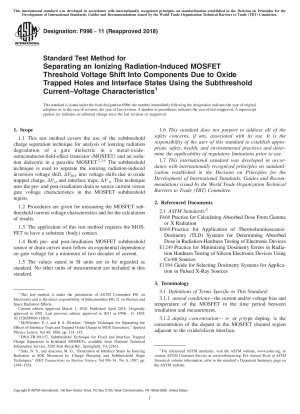ASTM F996-11(2018)
Standard Test Method for Separating an Ionizing Radiation-Induced MOSFET Threshold Voltage Shift Into Components Due to Oxide Trapped Holes and Interface States Using the Subthreshold Current–V
- Standard No.
- ASTM F996-11(2018)
- Release Date
- 2018
- Published By
- American Society for Testing and Materials (ASTM)
- Latest
- ASTM F996-11(2018)
- Scope
- 1.1 This test method covers the use of the subthreshold charge separation technique for analysis of ionizing radiation degradation of a gate dielectric in a metal-oxidesemiconductor-field-effect transistor (MOSFET) and an isolation dielectric in a parasitic MOSFET.2,3,4 The subthreshold technique is used to separate the ionizing radiation-induced inversion voltage shift, ∆VINV into voltage shifts due to oxide trapped charge, ∆Vot and interface traps, ∆V it. This technique uses the preand post-irradiation drain to source current versus gate voltage characteristics in the MOSFET subthreshold region. 1.2 Procedures are given for measuring the MOSFET subthreshold current-voltage characteristics and for the calculation of results. 1.3 The application of this test method requires the MOSFET to have a substrate (body) contact. 1.4 Both preand post-irradiation MOSFET subthreshold source or drain curves must follow an exponential dependence on gate voltage for a minimum of two decades of current. 1.5 The values stated in SI units are to be regarded as standard. No other units of measurement are included in this standard. 1.6 This standard does not purport to address all of the safety concerns, if any, associated with its use. It is the responsibility of the user of this standard to establish appropriate safety, health, and environmental practices and determine the applicability of regulatory limitations prior to use. 1.7 This international standard was developed in accordance with internationally recognized principles on standardization established in the Decision on Principles for the Development of International Standards, Guides and Recommendations issued by the World Trade Organization Technical Barriers to Trade (TBT) Committee.
ASTM F996-11(2018) Referenced Document
- ASTM E1249 Standard Practice for Minimizing Dosimetry Errors in Radiation Hardness Testing of Silicon Electronic Devices Using Co-60 Sources*, 2021-02-01 Update
- ASTM E1894 Standard Guide for Selecting Dosimetry Systems for Application in Pulsed X-Ray Sources
- ASTM E666 Standard Practice for Calculating Absorbed Dose From Gamma or X Radiation
- ASTM E668 Standard Practice for Application of Thermoluminescence-Dosimetry (TLD) Systems for Determining Absorbed Dose in Radiation-Hardness Testing of Electronic Devices*, 2020-07-01 Update
ASTM F996-11(2018) history
- 2018 ASTM F996-11(2018) Standard Test Method for Separating an Ionizing Radiation-Induced MOSFET Threshold Voltage Shift Into Components Due to Oxide Trapped Holes and Interface States Using the Subthreshold Current–V
- 2011 ASTM F996-11 Standard Test Method for Separating an Ionizing Radiation-Induced MOSFET Threshold Voltage Shift Into Components Due to Oxide Trapped Holes and Interface States Using the Subthreshold Current-Voltage Characteristics
- 2010 ASTM F996-10 Standard Test Method for Separating an Ionizing Radiation-Induced MOSFET Threshold Voltage Shift Into Components Due to Oxide Trapped Holes and Interface States Using the Subthreshold Current-Voltage Characteristics
- 1998 ASTM F996-98(2003) Standard Test Method for Separating an Ionizing Radiation-Induced MOSFET Threshold Voltage Shift Into Components Due to Oxide Trapped Holes and Interface States Using the Subthreshold Current-Voltage Characteristics
- 1998 ASTM F996-98 Standard Test Method for Separating an Ionizing Radiation-Induced MOSFET Threshold Voltage Shift Into Components Due to Oxide Trapped Holes and Interface States Using the Subthreshold Current-Voltage Characteristics
